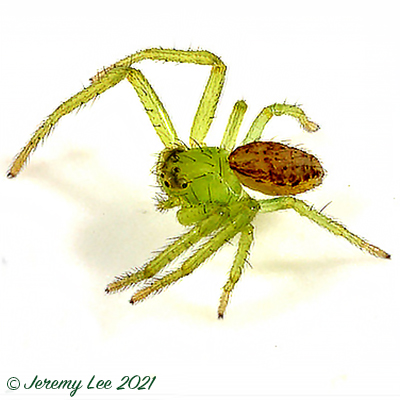
 |
|
Scientific Classifications explained » Amphibians » Ants » Aphids » Bees » Beetles » Birds » Bugs » Butterflies » Caterpillars » Damselflies » Dragonflies » Earwigs » Flies » Frog/Leafhoppers » Fungi » Galls » Grasshoppers » Harvestmen » Hoverflies » Lacewings » Ladybirds » Leaf Mines » Lichens » Mammals » Millipedes » Mosses » Moths » Sawflies » Slugs » Snails » Spiders » Trees & Shrubs » Wasps » Wild Flowers » Woodlice » Postboxes |
UK Nature > Spiders > Diaea dorsata

Scientific Name: Diaea dorsata Common Name: Green Crab Spider Diaea dorsata is one of the smaller crab spiders. Females can grow up to 6 mm, males up to 4 mm. Prosoma (head and thorax area) and legs are green, and the abdomen is yellowish with a red-brown mark. This spider can change its colour to fit its surroundings; however, the process takes several days. This species is strongly associated with woodland, perhaps with a preference for evergreens and conifers, and is found on the leaves of bushes and trees such as oak, box, yew and conifers, and is therefore usually collected by beating. It can also be found in leaf litter, and occasionally in the field layer of undisturbed scrubby grassland. Adults of both sexes are found mainly in May and June, females persisting occasionally into the late autumn. Diaea dorsata is locally widespread in the southern half of England, becoming scattered in the west and north as far as Yorkshire. |
|

https://www.uknature.co.uk is a website dedicated to showing the immense diversity of UK nature and wildlife. Our vast range of habitats, from lowland arable to snow covered mountains, from storm-ravaged coastlines to peaceful inland freshwater lakes and rivers, from dry, sandy heaths to deciduous and coniferous forests, all these habitats contribute to the abundance of UK nature. We have wild birds in huge numbers either residing or visiting our shores (597 recorded species as at July 2013) and we must also not forget the humble back garden with its grass lawns, flower beds filled with nectar rich flowers, shrubs and trees, all designed to attract huge numbers of insects such as bees, moths, butterflies and hoverflies; and finally the small ponds which provide safe havens for frogs, toads, newts and even slow worms and grass snakes. www.uknature.co.uk is the showcase for my personal passion, photographing uknature in all its glory. I sincerely hope you all enjoy the fruits of my labours. This site and all images contained therein is © Jeremy Lee 2004 - 2025. All Rights Reserved. Site design by Jeremy Lee. Site development & IT Support by Stuart Lee. |